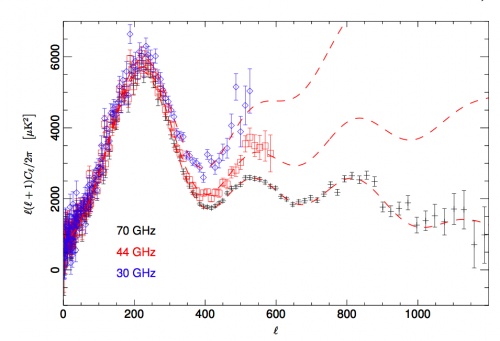Difference between revisions of "L3 LFI"
(→Power Spectra) |
|||
| Line 1: | Line 1: | ||
== Power Spectra == | == Power Spectra == | ||
| − | LFI temperature power spectra are computed from frequency maps using a cROMAster, a implementation of the pseudo- | + | LFI temperature power spectra are computed from frequency maps using a cROMAster, a implementation of the pseudo-<math> C_\ell</math> method described in <cite>#hivon2002</cite> extended to derive both auto- and cross-power spectra (see <cite>#polenta2005</cite>) for a comparison between the two estimators). Noise bias and covariance matrix have been computed through the Full Focal Plane Simulations version 6 “FFP6”, that include 1000 realization of both signal and noise maps consistent with Planck data. The angular response of the instrument is accounted for by using the beam window functions presented in <cite>#planck2013-p02d</cite>. Coupling kernels to correct for uncompleted sky coverage are computed as described in Annex. B of <cite>#planck2013-p08</cite>. We have masked Galactic plane and point sources using masks described in Sec. 3 of <cite>#planck2013-p06</cite>. In particular, we have used the 70% Galactic mask for 44 and 70 GHz, while we have used the 60% Galactic mask for 30 GHz. |
We report in Fig. 1 the 30, 44, and 70 GHz temperature power spectra. These have been produced from frequency maps without performing component separation. Nevertheless, there is a clear agreement between the observed spectra and the Planck Likelihood Code bestfit (<cite>#planck2013-p08</cite>) when adding a simple foreground component to account for unresolved point source residuals. | We report in Fig. 1 the 30, 44, and 70 GHz temperature power spectra. These have been produced from frequency maps without performing component separation. Nevertheless, there is a clear agreement between the observed spectra and the Planck Likelihood Code bestfit (<cite>#planck2013-p08</cite>) when adding a simple foreground component to account for unresolved point source residuals. | ||
| Line 19: | Line 19: | ||
--> | --> | ||
| + | == References == | ||
| + | |||
| + | <biblio force=false> | ||
| + | #[[References]] | ||
| + | </biblio> | ||
== References == | == References == | ||
Revision as of 22:00, 14 March 2013
Power Spectra[edit]
LFI temperature power spectra are computed from frequency maps using a cROMAster, a implementation of the pseudo- method described in #hivon2002 extended to derive both auto- and cross-power spectra (see #polenta2005) for a comparison between the two estimators). Noise bias and covariance matrix have been computed through the Full Focal Plane Simulations version 6 “FFP6”, that include 1000 realization of both signal and noise maps consistent with Planck data. The angular response of the instrument is accounted for by using the beam window functions presented in #planck2013-p02d. Coupling kernels to correct for uncompleted sky coverage are computed as described in Annex. B of #planck2013-p08. We have masked Galactic plane and point sources using masks described in Sec. 3 of #planck2013-p06. In particular, we have used the 70% Galactic mask for 44 and 70 GHz, while we have used the 60% Galactic mask for 30 GHz. We report in Fig. 1 the 30, 44, and 70 GHz temperature power spectra. These have been produced from frequency maps without performing component separation. Nevertheless, there is a clear agreement between the observed spectra and the Planck Likelihood Code bestfit (#planck2013-p08) when adding a simple foreground component to account for unresolved point source residuals.
The details can be found in #planck2013-p02.
References[edit]
<biblio force=false>
</biblio>
References[edit]
<biblio force=false>
</biblio>
(Planck) Low Frequency Instrument
